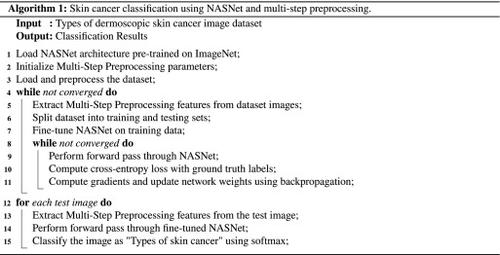当前位置:
X-MOL 学术
›
Image Vis. Comput.
›
论文详情
Our official English website, www.x-mol.net, welcomes your feedback! (Note: you will need to create a separate account there.)
An improved skin lesion detection solution using multi-step preprocessing features and NASNet transfer learning model
Image and Vision Computing ( IF 4.7 ) Pub Date : 2024-03-05 , DOI: 10.1016/j.imavis.2024.104969 Abdulaziz Altamimi , Fadwa Alrowais , Hanen Karamti , Muhammad Umer , Lucia Cascone , Imran Ashraf
Image and Vision Computing ( IF 4.7 ) Pub Date : 2024-03-05 , DOI: 10.1016/j.imavis.2024.104969 Abdulaziz Altamimi , Fadwa Alrowais , Hanen Karamti , Muhammad Umer , Lucia Cascone , Imran Ashraf

|
Computer-aided diagnosis has shown its potential for accurate detection of various diseases like skin lesion. Skin lesion has been recognized as a challenging task since manual identification through visual analysis of images can be inefficient, tedious, and error-prone. Although automatic diagnosis approaches are used to overcome this challenge, it is crucial to address problems such as variations in the size of images, presence of hairs in images, unsatisfactory schemes of colors, ruler markers, low-contrast, and differences in dimensions of lesions, and gel bubbles. Researchers in the field of dermatology pigmented lesion classification have proposed different methodologies to confront this issue. Specifically, they have focused on the binary classification problem of distinguishing Melanocytic lesions from normal ones. In this research, the dataset “MNIST HAM10000” is utilized, published by International Skin Image Collaboration, and contains data about 07 different skin cancer types. Moreover, in this research, we have focused on image preprocessing and skin lesion detection with NASNet model. Experimental reuslts demonstrated the superiority of the proposed model, which achieves an accuracy of 99.85%. This accomplishment has been made possible with the utilization of data augmentation techniques and multi-step image processing methods with the proposed NasNET model.
中文翻译:

使用多步骤预处理功能和 NASNet 迁移学习模型改进的皮肤病变检测解决方案
计算机辅助诊断已显示出其准确检测皮肤病变等各种疾病的潜力。皮肤病变被认为是一项具有挑战性的任务,因为通过图像的视觉分析进行手动识别可能效率低下、乏味且容易出错。尽管自动诊断方法可用于克服这一挑战,但解决诸如图像大小变化、图像中是否存在毛发、颜色方案、标尺标记不令人满意、对比度低以及病变尺寸差异等问题至关重要和凝胶气泡。皮肤病色素病变分类领域的研究人员提出了不同的方法来解决这个问题。具体来说,他们专注于区分黑素细胞病变和正常病变的二元分类问题。在这项研究中,使用了国际皮肤图像协作组织发布的数据集“MNIST HAM10000”,其中包含有关 07 种不同皮肤癌类型的数据。此外,在本研究中,我们重点关注 NASNet 模型的图像预处理和皮肤病变检测。实验结果证明了该模型的优越性,准确率达到99.85%。这一成就是通过利用数据增强技术和多步骤图像处理方法以及所提出的 NasNET 模型实现的。
更新日期:2024-03-05
中文翻译:

使用多步骤预处理功能和 NASNet 迁移学习模型改进的皮肤病变检测解决方案
计算机辅助诊断已显示出其准确检测皮肤病变等各种疾病的潜力。皮肤病变被认为是一项具有挑战性的任务,因为通过图像的视觉分析进行手动识别可能效率低下、乏味且容易出错。尽管自动诊断方法可用于克服这一挑战,但解决诸如图像大小变化、图像中是否存在毛发、颜色方案、标尺标记不令人满意、对比度低以及病变尺寸差异等问题至关重要和凝胶气泡。皮肤病色素病变分类领域的研究人员提出了不同的方法来解决这个问题。具体来说,他们专注于区分黑素细胞病变和正常病变的二元分类问题。在这项研究中,使用了国际皮肤图像协作组织发布的数据集“MNIST HAM10000”,其中包含有关 07 种不同皮肤癌类型的数据。此外,在本研究中,我们重点关注 NASNet 模型的图像预处理和皮肤病变检测。实验结果证明了该模型的优越性,准确率达到99.85%。这一成就是通过利用数据增强技术和多步骤图像处理方法以及所提出的 NasNET 模型实现的。



























 京公网安备 11010802027423号
京公网安备 11010802027423号